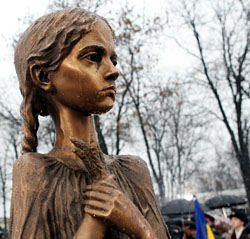Deadly orphanage
The building where over 700 children starved to death in 1932–33 is still there
Hard facts have been established, revealing the horrible truth about the death of small inmates of an orphanage in downtown Zaporizhia 75 years ago. The city learned the tragic story after the city council’s commission on toponyms began discussing the possibility of installing a memorial sign dedicated to the inmates of the Children’s Home who died in 1932–33. The evidence, which was discovered almost accidentally, is hair-raising: over 700 inmates of the orphanage, aged between one day and four years, died within a year and a half. Most often the cause of death, as recorded in the archives, was emaciation, intoxication, gastritis, and others. In fact, the small children died of chronic undernourishment. The horrible specter of the Holodomor caught up with them where they were supposed to be rescued and cared for.
Children’s cases were found in the archives a year ago, long before the official measures regarding the Holodomor, by Anatolii Peniok, an amateur ethnographer and foreman at the Zaporizhstal Steelworks. “We learned about the death of 30 orphanage inmates back in 1993 but were unable to locate the institution, he says, so I decided to find it and started digging up the state archives.” Leafing through public registry files of what was at the time Stalin district, reading handwritten entries faded with time, Peniok came across a large number of death certificates relating to infants and pointing to the same location: Children’s Home at 7 Rosa Luxembug St., or just a children’s home, without an address but with the same names of the medical staff. He checked the records from May 21, 1932, through Nov. 30, 1933 and meticulously copied the children’s names, drawing up a list of 755 names. Peniok feels sure that a further study of these documents would reveal quite a few silent tragedies.
YURII DNIPROSTROI AND BERNARD SHAW
I have followed in the footsteps of the above-mentioned foreman and the archivists who were tasked with answering a request from the Zhovtnevy district city state administration, and studied the demographic records. I could not help crying as I turned the pages of archival documents. Not a single day would pass at the orphanage without a small inmate’s death; sometimes five to six deaths were registered within 24 hours. Nine children died on May 21, 1933, when the famine was exacerbated by a measles epidemic.
The names of many children are proof of their status as foundlings (e.g., Yurii Dniprostroi, Ivan Stantsiiny, Mykola Fevralsky, Frosia Yuzhna, Nina Dyspanserna, etc.). After exhausting the list of ordinary names, the orphanage’s personnel turned to those of past celebrities: Bernard Shaw, Anna Akhmetova (sic), Lesia Ukrainka, and so on. Yet children died all the same.
A MAN WITH A FULL BELLY THINKS NO ONE IS HUNGRY
Peniok’s discovery became known to Dr. Fedir Turchenko, who holds a Ph.D. in History and is a member of the Zaporizhia City Council’s commission on toponyms. He was in charge of the Zaporizhia volume of the National Book of Memory: victims of the 1932–33 Holodomor in Ukraine. He was stunned by the functionaries’ cynicism at the time: “That orphanage was … on Rosa Luxemburg St., where there also was the prosecutor’s office, district council, finance department, and other institutions. The Soviet bureaucrats could not have been ignorant of what was happening in a building they passed by every day on their way to work.”
Referring to official documents, Dr. Turchenko notes that the children’s homes in what is now Zaporizhia oblast and what was then part of Dnipropetrovsk oblast had some 40,000 inmates. Peasant parents would often purposefully abandon their babies in that relatively well-supplied industrial area, hoping the foundlings would be spared death by starvation. Vain hopes.
Turchenko is sure that the Soviet civil servants did not suffer from the famine because they received food from special distribution centers that did not cater to the public at large. Proof of this is an archival directive establishing food rations for the senior officials of the Melitopil district executive committee (the first figure indicates the amount per the head of the family and the second one, per a dependent of up to 14 years of age): 600-800/400 grams of bread and 1.0/0.5 kilogram of cereals were part of the daily rations. The monthly rations included 3.5 kilograms/500 grams of meat; 1.5 kilogram/400 grams of sugar, etc. It stands to reason that the bureaucrats in Zaporizhia did not have poorer rations than their counterparts in the province.
A MEMORIAL PLAQUE
The street that used to bear the name of Rosa Luxemburg now boasts the name of another revolutionary, Felix Dzerzhinsky. Building No. 7 now accommodates the state treasury department and a veterinary clinic. Historians do not have direct evidence that this building once housed the orphanage, but the probability is very high. It is an old structure, located at an intersection, just like that Children’s Home in the 1930s. Be that as it may, the initiators of the memorial project believe that the main thing is not the exact address but the memories of innocent children’s souls.
“It would be improper to remind people who work here of the sad events of the past every day,” says Mykhailo Levchenko, a member of the commission on toponyms, “so we agreed on a memorial plaque on the wall joining building No. 7 and the next building.”
The initiative of the city council members and the public has been supported by the experts at the city’s architecture and urban planning directorate. Hopefully, the red tape that started last spring will finally end and memories of the children who happened to be born in that horrible period will not sink into oblivion.






